Frances and I are heading to Zambeze Delta Safaris‘ Mozambique hunting concession in November. This concession, known as Coutada 11, is famous for the richness of its game animals; Sable, Reedbuck, Waterbuck, Nyala and many more species are present in incredible numbers. However, the one animal that Coutada 11 is probably best known for, is the Cape Buffalo. With over 25,000 animals, this area is known for huge herds that hang out mostly in the swampland associated with the Zambezi River.
I have written elsewhere that I’ll be carrying one of MG Arms’ Ultralight rifles chambered in .416 Taylor to use for Cape Buffalo (TTAG review). However, as I’ve been planning the trip, I also wondered about trying for a buffalo with a rifle given to me by my late Dad.
My Dad gave this rifle to me not long before he passed away. It was a custom gun built for him by Bill Hall in Abilene, Texas using a pre-war Mauser action.
My Dad’s statement, “This caliber will take anything on this continent, from whitetail deer to brown bear” has been born out by hunters and gun writers like Elmer Keith and Craig Boddington. Keith wrote in Keith’s Rifles for Large Game of using the .35 Whelen to kill a huge brown bear. Boddington related an episode in his American Hunting Rifles in which he knocked a bull moose completely off its feet with this ‘pussycat’ of a caliber.
My Dad’s rifle is actually chambered in a wildcat round — .35 Whelen Improved — which allows it to be loaded a bit hotter than the .35 Whelen. I have taken large and tough animals with this rifle (elk in Colorado and Idaho, and zebra in South Africa) using 250-grain Hornady Interlock and Nosler Partition.


There is no caliber minimum to hunt Cape Buffalo in Mozambique, but just because you can legally do something, doesn’t necessarily make it a good idea. So, I called the outfitter/owner/PH, Mark Haldane, and asked his advice on using my .35 caliber rifle.
He asked about muzzle velocity and power levels for the 250-grain bullet I normally use. When I told him what they were (about 2600 fps and just shy of 4000 ft-lbs), Mark came back with, “Brother, the .35 will be perfect for buff, with Swift A-Frames.”
I need to state that I have extensive experience with (and enormous confidence in) a wide array of Hornady and Nosler bullets and ammunition. I also recognize that there are numerous other premium bullets and ammunition on the market that are designed to work on all sorts of game animals.
I have never used Swift bullets for hunting. However, Haldane and his PHs at Zambezi Delta Safaris take more than 100 Cape Buffalo every year. If he tells me to use a certain bullet, I’m going to set my own ideas aside and take his advice.
Because it’s a wildcat, I reload for the .35 Whelen Improved.
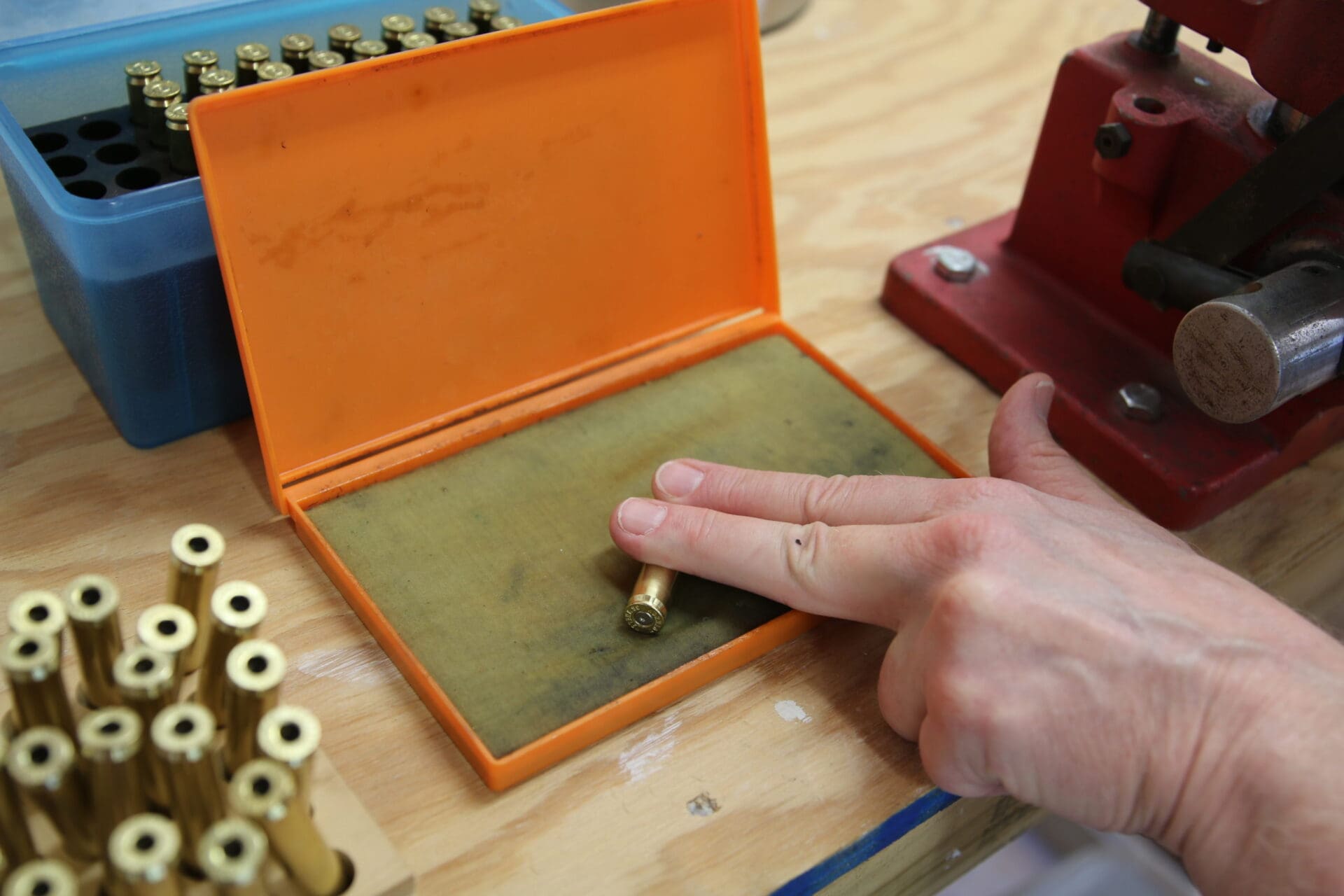
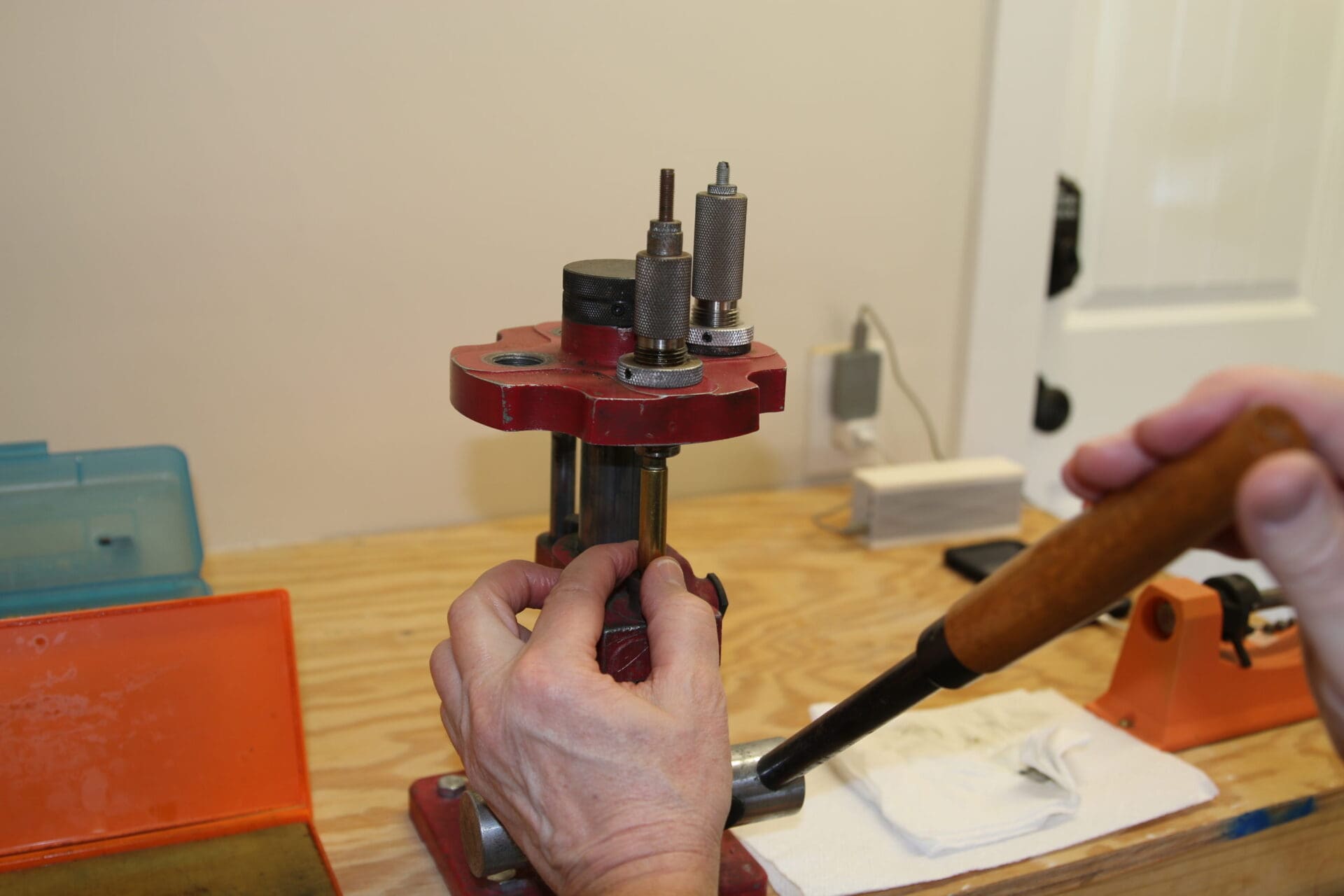

My Dad purchased the .35 Whelen Improved rifle nearly 60 years ago. I like the fact that I reload for this rifle using his original RCBS dies.
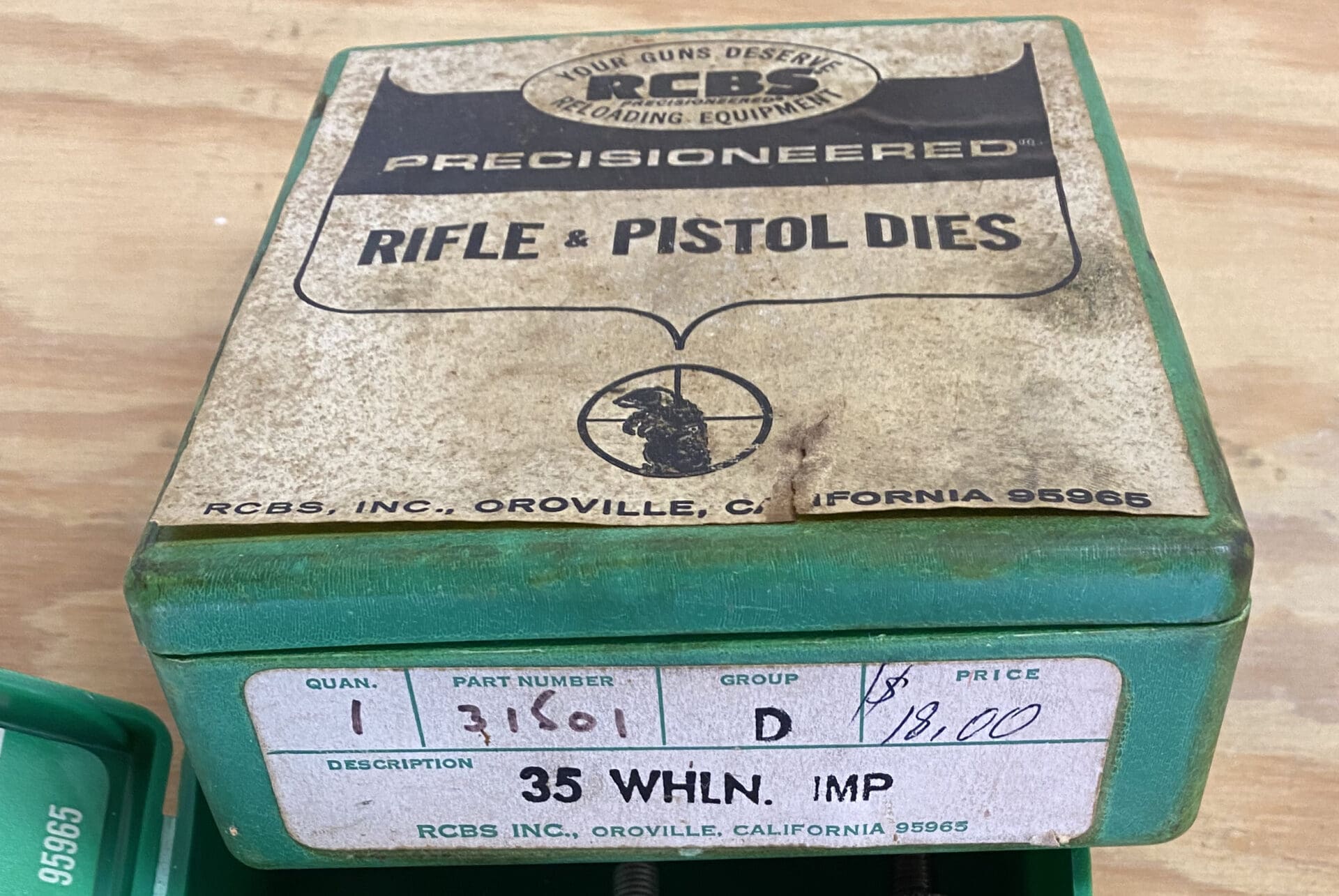
I started my quest to follow Mark’s advice by contacting Bill Hober, President and CEO of Swift Bullet Company. Bill has actually hunted Cape Buffalo with Mark Haldane. When I related Mark’s requirement to Bill, I assume it made him smile. Regardless, he agreed to send me some of their .35-caliber, 250-grain A-Frames.
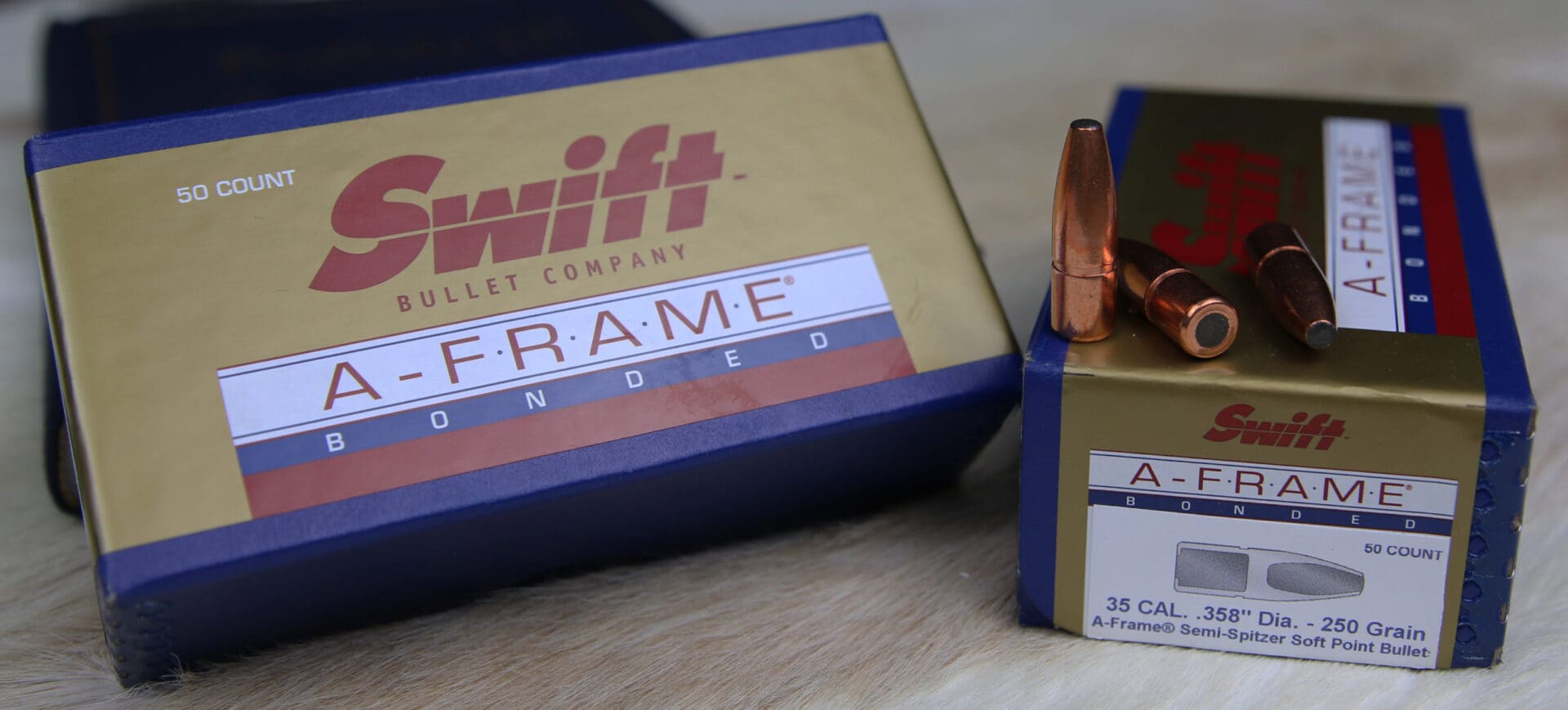
While waiting for the A-Frames to reach me, I dug into the reloading literature to see if I could come up with a different formula than I had been using with the Hornady and Nosler bullets. All of my research ended up confirming that the load my Dad had written down in a note to me when he gave me the rifle was still the most generally recommended: 54-grains of IMR 4064 behind a 250-grain bullet. So that’s what I used in my first series of loads with the newly-arrived Swift A-Frames.
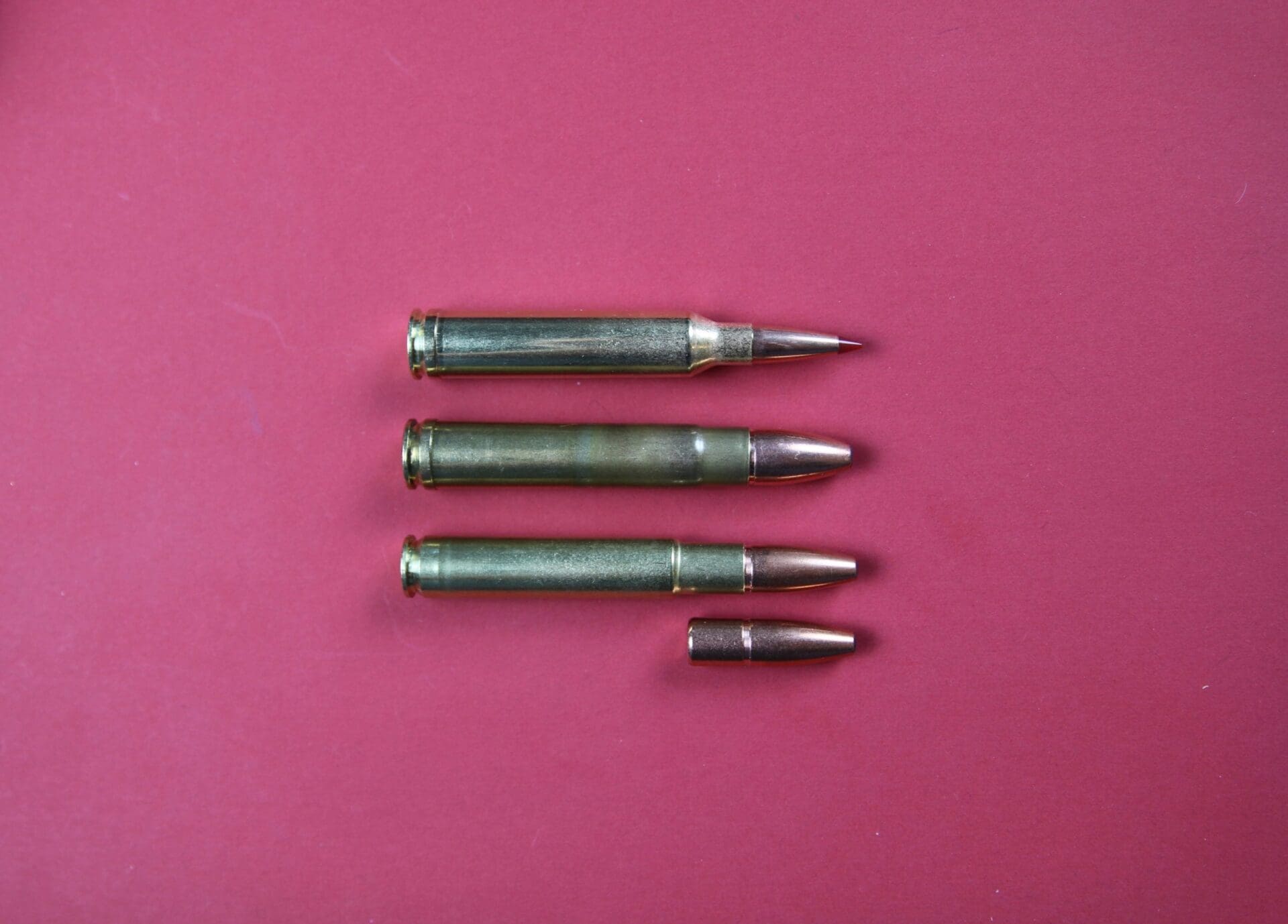
Both from the bench . . .
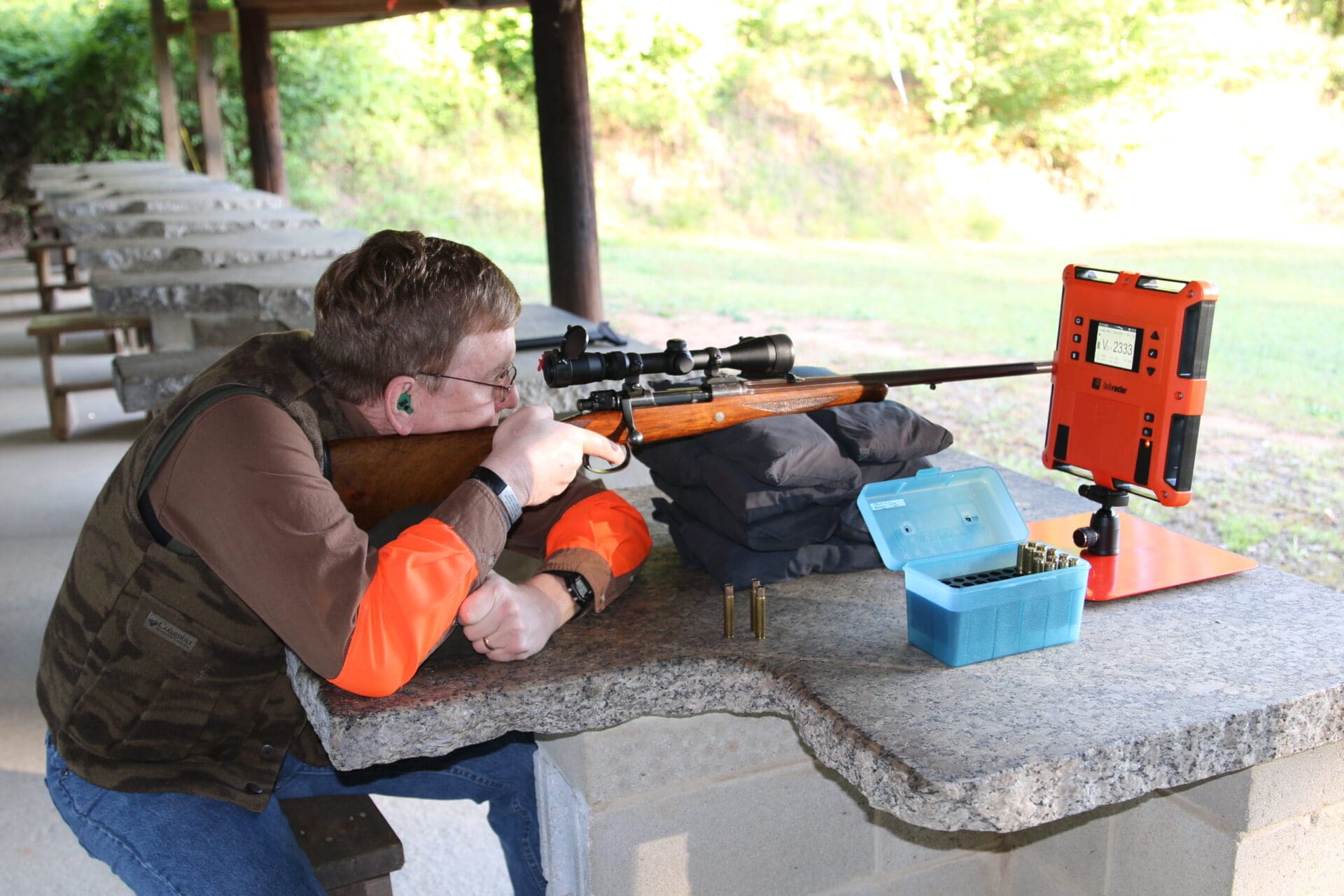
…and the 4StableSticks’ ‘Sit Stick‘ fieldrest (to be used on the buffalo hunt in Mozambique), I was able to record a bit over MOA-size groups at 100 yards. That is normal performance for this rifle.
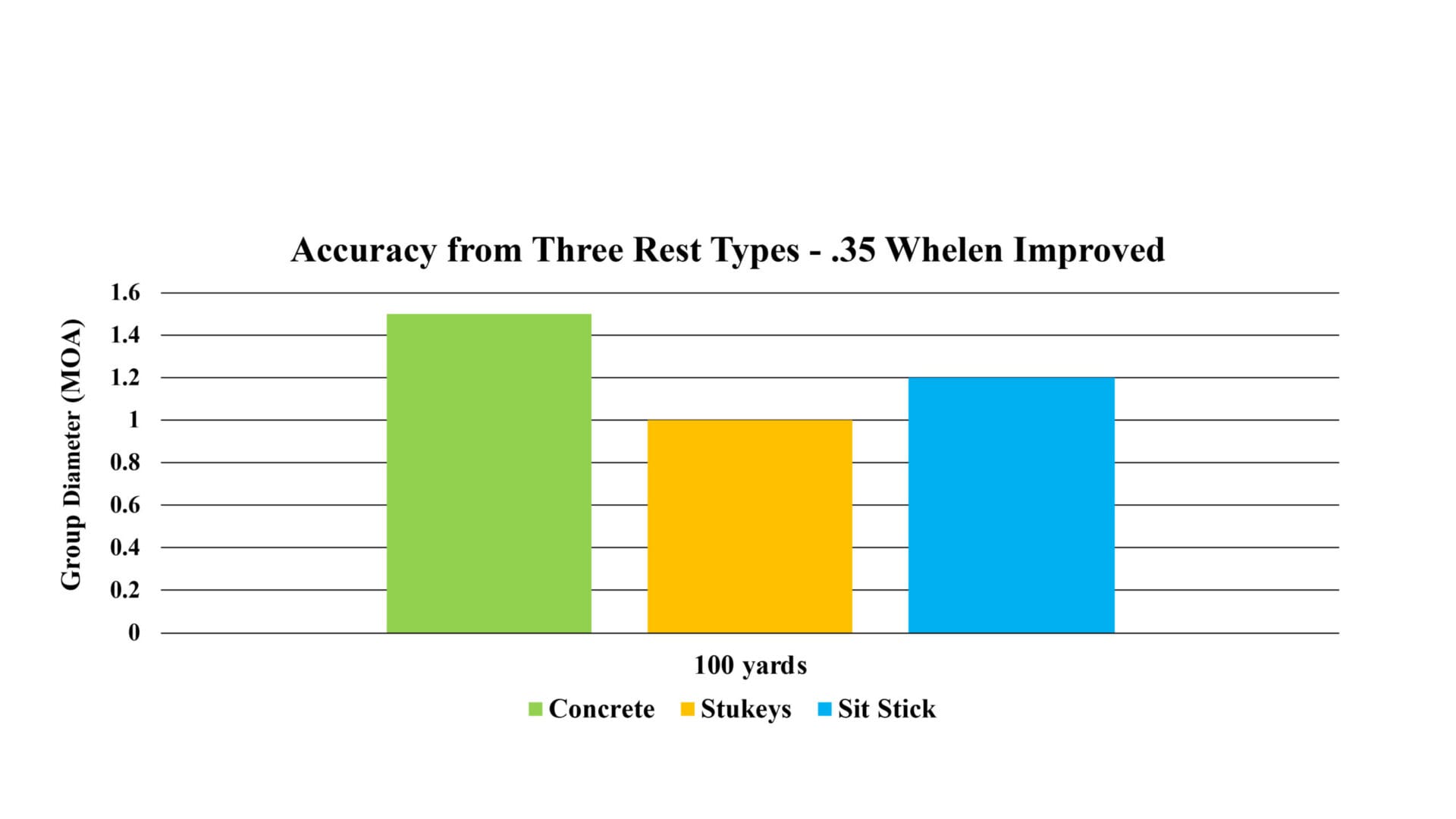
According to Haldane, I won’t be shooting further than 150 yards — and more likely around 100 yards — at one of their Cape Buffalo. That means, given no shooter error, I will be able to place Mark’s recommended bullet into an approximately one-inch circle nestled within a heart-lung area that’s much larger than one inch.

Now I just have to reload more A-Frames and practice, practice, practice.
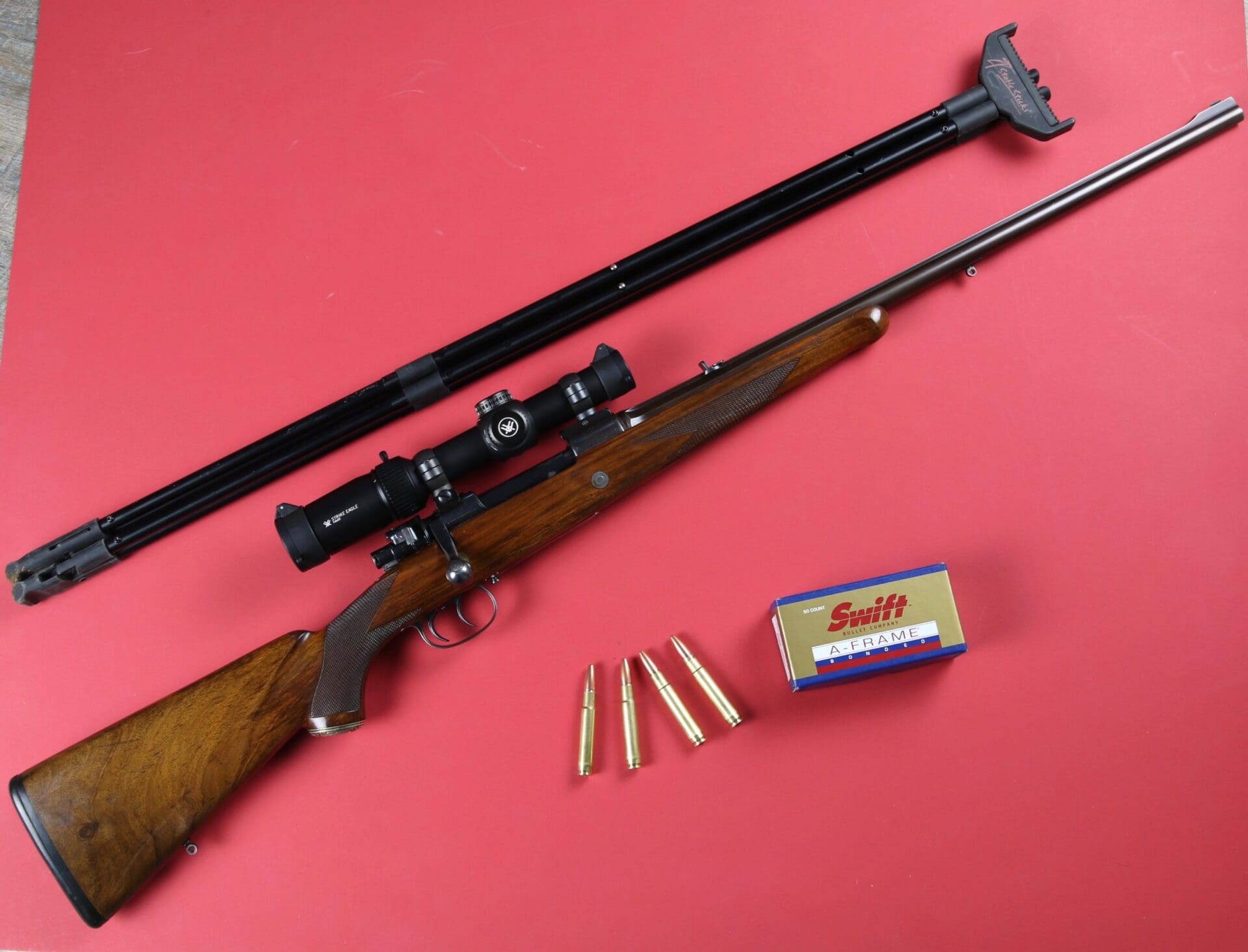
Mike Arnold writes for a number of outlets; links to other articles can be found here.
All images courtesy the author.

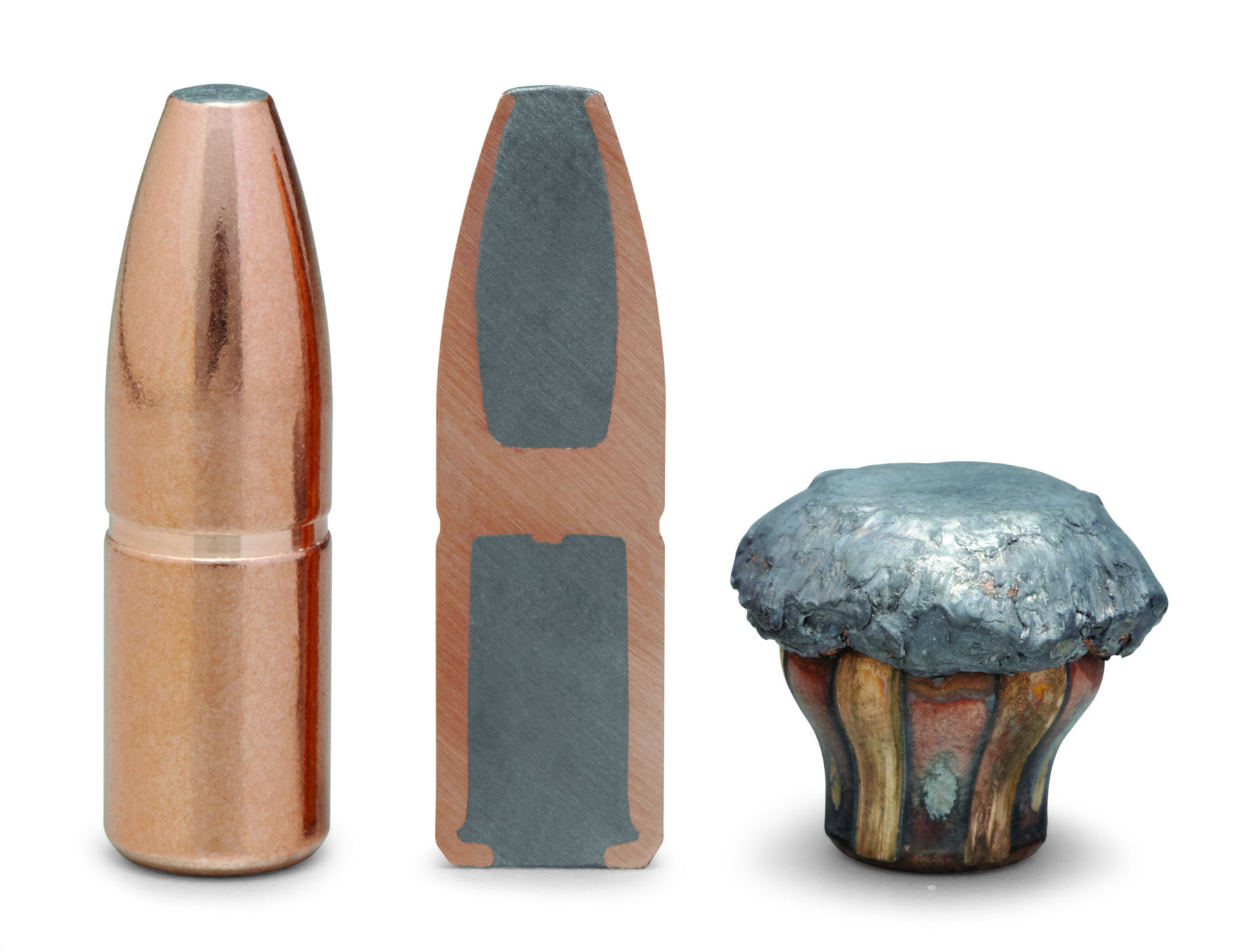



Did you try 35 Remington?
That rifle is a beaut, the shooting sticks are neat and the idea that you’re reloading your dad’s gun with his stuff is very cool. Don’t know much else that needs to be said here. Good luck on your hunt.
Thanks Andrew. It makes me wish I had treated my Dad better when I was a cocky teenager!
Ha!,that’s all of us now that we’ve reached dads age now.I used to think man is he full of it at times !Now looking back it seems dad was a wise old bird after all!
I don’t think I’d want to hunt Cape Buffalo with anything smaller than an anti-material rifle at 800 to 1000 yards.
“I don’t think I’d want to hunt Cape Buffalo with anything smaller than an anti-material rifle at 800 to 1000 yards.”
You and be both, brother!
After hearing Tom’s African safari story a year or so back, I’d be comfortable hunting Cape with a .50 BMG, on the low end…
I say we take off and nuke the site from orbit.
It’s the only way to be sure…
Park a helicopter about fifty feet back of the shooting position with rotors spun up and those distances would feel way better to me.
Alternatively, there’s always YouTube…..
.35 Whelan Improved on a custom Mauser action? That satisfies the social distance ruling.
Um, if you are almost certainly limited to 100 yards, why not use a heavy hardcast bullet with large, flat meplat?
People report hitting North American bison with a .45 caliber, 350 grain (or thereabouts) hardcast lead bullet with an impact velocity of something like 900 fps and they claim that the terminal ballistics are devastating — resulting in those 2,000 pound bison going down in very short order.
I would think that a heavy-for-caliber hardcast lead bullet will take a cape buffalo better than any other type of bullet, if the impact velocity is at least 2,000 fps.
Yea but capes are fuel injected turbo supper charged nitrous fueled killing machines!
That is a beautiful rifle. Very nice work.
I’ve never heard of Mr Hall, but she sure is a beaut. Bet she points very nicely indeed.
Sorry but the old standard was .375 H&H. I wouldn’t hunt Buffalo with anything less. But to each their own.
Joseph,
Some countries have rolled back their minimum bore & energy requirements for hunting rifles, some have dropped the minimum bore but still have a requirement for muzzle energy (eg, Namibia requires 5,400 Joules) and some still have a minimum bore and energy requirement.
.375 H&H is a safe choice, but from a standpoint of making a custom rifle, the .375 needs a “magnum-length” action, whereas the 9.3×62 and .35 Whelen can use a standard-length action and get you most of the way there. With newer powders and reloading, you can get pretty darn close to 5,000 J of muzzle energy in the 9.3 and .35 Whelen. I don’t think someone using either the 9.3 or .35 Whelen would be under-gunned, but they’d have to hand-load to get the best performance possible.
If I ever go to Africa, I think I’ll make a rifle, and since I’d base it on a magnum-length action, I’ll go past the .375 H&H and go for something even older, like a .404 Jeffery. If someone were to ask me “Why aren’t you using a .375 H&H?” I would reply “I don’t trust these new-fangled cartridges the kids find so fashionable these days…”
Thanks DG. I was wondering about length when I read 54 grains of 4064.
Looks like a pretty neat caliber.
Tom, it’s just a ’06 necked up to take a 0.358″ bullet.
The .35 Whelen is to the .30-06 and 1903 Springfield rifle what the 9.3×62 Mauser is to 8×57 and the Mauser 98 rifle.
Otto Bock came up with the idea of the 9.3×62 in 1905 in Berlin, and Howe (of Griffen & Howe gunsmiths in NJ) and Adolph Niedner (more commonly known in gun circles as “A.O. Neidner” of Massachusetts ) to come up with the .35 Whelen in 1922/1923 or thereabouts. Both are excellent ideas; they produce significant improvements in terminal ballistics on large, tough game over a .30-06 or similar class rifle.
When one looks at what both these cartridges are capable of, we see that a whole lot of mid-range magnum development over the last, oh, 70+ years was never needed. I’ve made one of each for myself – the 9.3 on a Mauser action, and the .35 on a 1903A3 action. They both work fine, both have about a #6 contour barrel in 24″. Compared to my .338 WM, they’re both much less abusive in recoil.
Speaking from absolutely no experience with big dangerous critters, why not go bigger?
As a boy I was knocked clear across the shooting line, back onto the gravel and flat on my back by a .470 Nitro Express. I do not recall the flight, I was apparently briefly out cold. Impressed the hell out of me, and somewhat displeased the fellow who’s fancy rifle I dropped on the concrete.
I figure if it’s dangerous African game, go large. That .470 ought to do the deed.
And send that idiot that handed a boy an elephant gun and said “Hey kid, wanna’ try a man’s gun?” to do the shooting.
DS, I trust your opinion on rifles for sure. That being said how low (in power and diameter) can you go? Can my old .300 Win Mag take dangerous game? On paper it sure has more power than any Whelen but it is obviously lacking bigger bullets. I know even the old .303 British was used on African game with decent success but it just seems a little unethical to me.
Not going to happen anytime soon but if I was going Buffalo hunting and the various possibilities a person might encounter, the one thing that a man can control when facing such game is how much gun is brought to the equation. If it was up to me I would probably be using a .378 or .460 Weatherby. Although reading about that .404 Jeffrey is very interesting. I would trust that more than a Whelen for sure.
I honestly have no idea “how low can you go?”
This is like the same question on bears here in North America. How low do you want to go? Plenty of bears, some of very impressive size, have been taken with .30-06, even .270 Winchester. There’s a heck of a big bear currently under glass in a casino in Elko, Nevada that was taken with a ’06. Do you “want” to do this? Well, that’s your call. Do you feel lucky?
The big beasts like the Cape Buff, hippo’s, elephants and so on – those rifles need to deliver mass and penetration. This is why you see hunters using “solids” – brass or copper bullets that are solid metal, and they don’t deform much. They smash through bones (plural) and keep plowing through in a straight line. I suppose the smallest I, personally, would go is to the .338 area, where I could find the sorts of premium bullets for this type of game, and the .338 WM/.340 Wby has enough power to shove a solid deep into or through an animal.
If I ever get a chance to go to Africa, I’ll likely do exactly what the author has done here – call his PH and talk to him about game he’s hunting and what rifle/load to bring. I’ve talked to some PH’s (at SCI shows here in the states) who have told me that you really do need to talk to your PH about the situation and game you will be encountering – some PH’s have told me that in “X” region of a country, the buffs might be more placid and calm, and in other areas/regions of the country, they’re much more snotty and on the fight. In other words, “one size might not fit all.” If you hire an outfitter, the money you’re paying them includes such getting advice on such things as pre-trip planning and things like choice of load, obtaining ammo, etc.
The .375 H&H became one of the most popular cartridges of dangerous game hunting for a reason. It’s quite versatile, and it has proven itself over the years. Invented in 1912, it is the first of the “belted magnum” cartridges, and today, most people have no idea why H&H put a belt on it. I could explain that if people wish. At the time it came into being, the “dangerous game” cartridges of the day were rimmed cartridges, made for double rifles. They were also just barely into the era of smokeless powders, with their much higher pressures and velocities. When Otto Bock created the 9.3×62 in a Mauser 98 action, the sudden success of the 98-based rifles was such that the fine gunmakers of the UK figured “We’d better get on this trend, if we’re going to keep making money….” because the bolt action rifles reloaded fast enough that many hunters were buying the bolt guns, which sold for a much lower price than double rifles. The .375 H&H cartridge could be put into both bolt guns as well as double rifles.
Then you see a tremendous amount of cartridge & load development in the 10mm/.400 area, and then you jump up to about .470’s and .500/.505. If I were looking to take a maximum rifle, I think it would be a .505 Gibbs, but that’s a whole lot of work. I’ve seen a sweet .505 Gibbs that was built on a 1917-pattern Enfield (which started as a .30-06 US military rifle). It was a bunch of work, but the results were quite nice.
If someone were going to Africa and they had no idea and no time to select a rifle, I’d say that they could probably rent a competent rifle from their PH/outfitter – they’re not going to rent weapons that will get their clients killed, but those rifles won’t fit all clients, nor will you have a lot of opportunity to become very good with the rifle. Ammo for these rifles costs big bucks.
You should write a book on the history of rifles. Good stuff!
I don’t have any experience with the whelen. However, I’ve taken a pile of game with a 9.3×62 and in my experience and with anecdotal evidence from several reliable African PH’s I wouldn’t feel undergunned. Last PH I spoke with said that under 200yds you’ll never notice a difference in killing power between a 9.3×62 and a 375. That is why several countries have a carve out for it in the dangerous game policies. You won’t really see a difference in killing power until you begin to move into the real “stopping” rifles ie. 458 Lott and the lot…. see what I did there.
Just make sure you do not take handloads to Africa for your guided hunt. So many hunters have been disappointed, showing up with rounds that OAL was improper and wouldn’t chamber, or a bad batch of primers, squibs etc.
These hunters go through ridiculous paperwork to have their firearms in country, and end up with a useless block of wood and steel. And worse end up using a PH’s beater gun for their once in a lifetime hunt.
Use a common caliber, use factory loads.
So much truth here. I actually received my first centerfire rifle because my grandfather had commissioned a Mauser based 6.5 – 308 for an upcoming safari when he already owned a very nice x55. His partner (and BIL) quickly showed him the error of his ways and for my 12th birthday (sometime in the ’70s) I received a beautiful lh Mauser and 200 rds of ammo. Still got it, and plenty of that ammo and have taken game on a few continents with it over the years.
Fine looking rifle.
I think if I was able to do a Cape Buffalo hunt I’d want a guide on each side of me. Each of them toting a bigger gun than mine.
A much, much bigger gun than mine.
Great story and I’m glad you can shoot your dads rifle! However, Cape Buffalo don’t always fall to the first good shot or the tenth. If you have to follow up on a buff I hope that cartridge has enough juice and the bullet strong enough construction. If your PH will even allow you to tag along on the follow up. I haven’t been to Africa for a safari but when I do I’ll probably use a 45-70 lever gun with hard cast flat points or Underwood Xtreme Penetrators and get close. Hornady also makes DGS bullets with a steel jacket that would be good. You’ve got to have straight line penetration through the toughest bone to be sure of incapacitating these creatures. All the penetration you need without the ridiculous recoil and wasted energy with faster follow up shots. And no, I have zero problems with heavy recoiling rifles. The more, the better. Except when I need fast follow up shots. Good hunting! And I would use something like 30-06 for thin skinned game.
Chuck Hawks has a page for reloading the 45-70 up to 50,000 CUP for modern bolt guns or single shot rifles: “For the utmost in penetration on very large animals, the 500 grain Hornady RN or FMJ-RN bullets on top of 44.1 grains of IMR 3031 results in a MV of 1500 fps, and a maximum load of 53.1 grains of IMR 3031 can drive these 500 grain bullets to a MV of 1800 fps. Again, these high pressure loads were tested from the 22” barrel of a Ruger No. 1 rifle.
I can tell you from experience that these heavy loads kick like the devil, but they make the .45-70 a serious “stopping” caliber.”
The ‘follow-up’ rifle (I hope never needed!!) will be a .416 Taylor Texican. Again, I hope it isn’t needed!!
Have you ever watched any of Mark Sullivan’s videos? He gets up close and personal with wounded buffalo and even let’s his clients come along. Never in any thick bush though. But the videos of them taking charging buffalo and hippos are exhilarating. That’s what I want to do!
Never heard of the 35 Whelen “improved”
Got some experience with the 35 back in college at MIT (Murray In Tishomingo).
Interesting
It’s just a .35 Whelen with the shoulder angle steepened to 40 degrees, like all of PO’s “improved” cartridges. The amount of muzzle velocity increase is only about, oh, 50 to 75 fps, but the sharper shoulder makes it easier for the cartridge to headspace reliably on the shoulder.
Personally, I think the only “Ackley Improved” variant of PO’s that is still worth the effort is the .280. But that’s just my opinion. Most of PO’s “improved” cartridges have fallen by the wayside other than the .22-250 AI and the .280 AI. IMO, I would recommend someone play with newer powder technology before they go running a reamer into a stock chamber to steepen the shoulder, as PO used to do with the “improved” idea.
DG, I hope we can meet sometime. Every time you comment on one of my articles, I learn tons! Thanks for taking the time to instruct! Best, Mike
I appreciate that
Most likely will never hunt cape buffalo. I do wonder how many stacked Quigley’s you can get with it. Be pretty handy for riot clearing or anti vehicle work.
I don’t understand the predilection for shooting a horse (of any stripe) unless it is for ethical/humane reasons (to put it out of misery). C’est la soif de sang.
What, you have never eaten horse? I know that “horse” was eaten!
I have an innate aversion to consumption of animals that have an inimitable, benevolent bond with humans- horses, dogs, and cats, in my experience. Further, I don’t believe that cruelty toward any sentient being is morally defensible.
Horse consumption is currently not uncommon in the world.
Hey Pete, when’s Edie going to be singing at Mother’s again? Lt. Jacoby and I might swing by and catch the groove.
Sadly, Silly passed in 2017, and Chuck passed in 1986 (my senior year in high school).
Edie, ciao baby.
Zebra skin pants.
“Thirst for blood”? LoL. Eating horse is normal in France.
Knowing very little about rifle calibers outside the ones most everyone knows about (5.56, 7.62×39, .30-06, etc.), I always enjoy learning about one I’m not familiar with (or in this case, had never heard of before now).
Thanks Rookie – I am too, by the way (a Rookie). I love running in to and learning about different aspects to the shooting sports. The learning never ends for me!
A 338 with Barnes solids works fine on Buffalo. A 458 Win in a Ruger single shot with Barnes x bullets is also fine. One shot thru the heart will do it every time.
Been there done that. Learn to shoot!
I can’t add much to your choice of weapon but if Mark Haldane says it will work I’d trust his judgement he’s seen a lot buff taken in his area. I can compliment you on your choice outfitters and location. First class all the way, PH’s, accommodations, organization, food. You won’t be disappointed I had as a PH Rye Pleets a very competent PH who seems to be expert in many things from hunting to all areas of maintenance required to keep things moving. If you get Rye I’m sure you’ll be very pleased with him. When riding in one of those amphibious machines on the way to the swamp, hold on. I stayed at Ngazi camp and took my buff with a .416 Rigby using Hornady 400 gr DGX, 60 yard broadside he ran 50 yards and went down. We recovered the bullet under the skin on the offside took out both lungs and the heart. Good hunting.
Thanks Gordon. Frances and I cannot wait to get to the camp. We’ll also be collecting information for a book on Mark’s conservation success. Really looking forward to the whole experience!
According to the Hornady reloading app 9.3×62 is available factory in the CZ550 rifle.
How’s that hand load going to work in hot weather? How does it feed being improved, without the taper in hot weather?
It works really well in Georgia heat, Waylon. It will be a bit hotter in Mozambique in November, so I’ll write my next chapter on this hunt and let everyone know!
Strange that the 9.3×62 and the 35 Whelen are in the conversation, but the real mid-caliber who has the performance ballistics without pushing it even hard when handloading, is not…The 358 Norma Magnum is equal in performance to the 375 H&H, therefore, I will have it any time as my go-to rifle for dangerous game in NA, and as my backup rifle for all dangerous game in Africa, but elephant. If any doubt, crunch the numbers..I did.